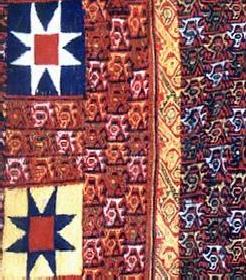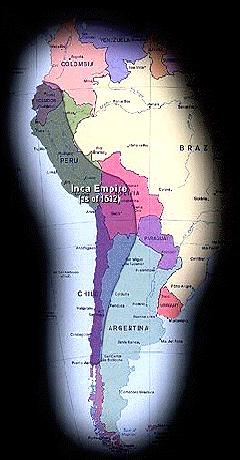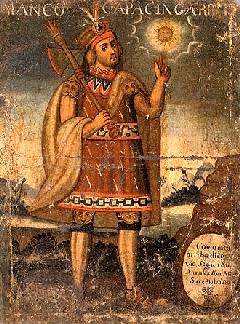|
ANDEAN TEXTILES IN HISTORICAL PERSPECTIVE (Page 1) Pallay of present times reflect the cultural and historical potpourri of the Central Andean: The last 500 years of the history of this region -comprising the periods known as: Conquest, Colony and Republican era, were preceded by several millennia of successive cultural flux that culminated in the efflorescence of Inca civilisation. Textile designs from these pre-Inca periods evolved in combination with motifs of Inca origin and with the admixture of yet more designs and techniques imported by the Spanish and other European influences, becoming eventually all incorporated into the repertoire of native "Pallay". At the time of the Spanish conquest, all of present-day Peru, Bolivia and Ecuador -as well as substantial portions of Colombia, Chile and Argentina- were under the rule of the Incas. The Incas were a social ruling class (rather than a "tribe" or a "nation"), descendants of an ethnic group which may have originally evolved in the vicinity of Cusco -though various myths of origin also show them emerging and migrating from Lake Titicaca to the Cusco region. This latter theory would seem corroborated by certain technological and religious elements in their culture (cultivation of maize, superior architecture and stone masonry, a monotheistic -and somewhat iconoclastic- religious tendency and an as-of-yet- undeciphered hieroglyphic writing prominently displayed in textiles and ceramics) which seem very directly related to and derived from a more ancient cultural "horizon": -the Tiahuanaco Culture- which was centred around Lake Titicaca (with important ramifications at Huari in the Peruvian Highlands of Ayacucho, in Nazca and in the Rimac Valley on the Peruvian coast) between 1000 BC and 500 AD The disintegration of this earlier "Tiahuanaco-Huari Empire" resulted in the collapse of the major urban centres and the dispersal of their populations. Cusco lies equidistant from both Tiahuanaco and Huari and situated on the principal communication route between both places. Pre Inca ruins of some importance in the Cusco valley (Pikillacta) evidence the Tiahuanaco-Huari presence here. It also lies at a point where the Urubamba and Apurimac rivers begin their northerly advance into the Amazon forests which then -as now- provided great and unlimited access to natural resources. It would seem reasonable that the original Inca clans would choose to settle in this valley after a period of exodus and migration. Whatever the case, the founding and settling of the valley and city of Cusco by the first "Incas" is traditionally assumed to have taken place approximately around the year 1200 AD The mythical Manco Capac and his sister/wife Mama Ocllo are credited with the act. As with most mythical personages, they were probably clan chiefs later deified by their descendants. There were other ethnic groups already living in the Cusco valley. Some of these became Incas through association and marriage. Others were displaced, yet others were probably conquered and became the basis for the underlying layers of future social classes subservient to the Incas. Cusco became the Inca capital, their power and influence radiated from this centre. In time it became the supreme capital of their "empire", known by the name of "Tawantinsuyo" (the four divisions, or quarters). Many regions of eastern South America, most notably the northern Peruvian coast and many areas south of Lake Titicaca and in northern Chile and Argentina, had been subjected to definitive Inca rule as recently as only 50 years immediately prior to the Spanish Conquest. All of the above are well known documented aspects of the history of pre-Columbian South America and more detailed studies and descriptions of this can be found in those works listed in the bibliography following these articles. Likewise, much has been written on the degrees of perfection and sophistication, as well as on the great variety of techniques of pre-Columbian and pre-Inca Textiles. It is not within the intentional domain of the present article to expound upon a subject so extensively dealt with elsewhere in numerous other, illustrious, works. It will suffice to indicate that this lay study initiates its condensed description of the evolution of indigenous Andean weaving with an examination of production at the time of the height of the Inca period -which is also that period of time immediately preceding the advent of the Spanish Conquest (1500 - 1532 AD)- to thenceforth proceed in leaps through the Comquest, Colonial, early Republican, Republican and 20th century periods. In most cases, the subject matter is also limited to textiles designed, produced and intended for utilitarian use (i.e.: garments, apparel, minor ceremonial purposes) and not those which may have been intended for decoration of houses, palaces, temples or (as in the case of many pre-Inca textiles) for funerary purposes. Textile production during the time of the last Incas seems to have fallen into two fairly distinct categories (within the above stated parameters): textiles produced in (and for) the Inca noble houses in Cusco and textiles of regional or provincial origin. The latter, while adhering to design parameters dictated by Inca patronage, retained certain autochthonous characteristics. Certain specific garments, such as Llicllas (women’s mantles), Chumpis (men’s belts) and Ch’uspas (coca bags) had reached, by this time, their final stage in overall development and had acquired the forms and general aspects which they retain to this day. Royal Inca garments were characterised by special, complex designs known as "Tocapu". These are now believed to have been a form of writing or perhaps the components of a heraldic code, but their significance has not yet been deciphered or satisfactorily explained. Examples of Tocapu are not exactly common -though by no means absolutely scarce. They apparently adorned all royal Inca tunics (Unkus) and Licllas in patterns of marked sequences. Tocapus differ greatly from pre-existing designs on textiles, particularly those from Coastal cultures. But they do bear resemblance to certain textile designs of pre-existing highland cultures, notably the Tiahuanaco-Huari. They consist of individual rectangles or squares containing geometric forms and colour combinations with many variables, yet always following clearly indicated sequences. These are most commonly found in textiles but are also depicted on certain ceramics and wooden cups (Kkeros). Hundreds of Tocapus have been identified individually, albeit combinations of them have been identified on the basis of those specimens and fragments found in museums and private collections. All of these belong to garments and textiles of noble Inca origin.. |
Manco Capac - Colonial Painting
|






